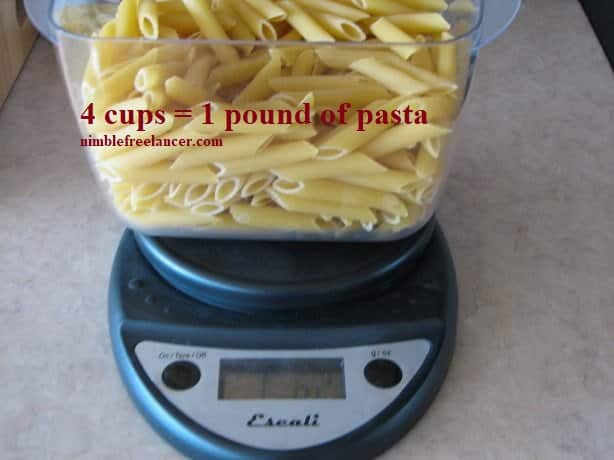Measuring dry pasta can be tricky, but it doesn’t have to be! You can use a few different methods to ensure you get the correct amount of dry pasta every time. Whether you’re making a big pot of spaghetti or need enough for two people, here’s how to measure dry pasta perfectly every time.

How Do You Measure Dry Pasta?
You can measure the dry pasta using a pasta measuring cup, kitchen scale, or your hands. The easiest way is to use your hand as a reference to measure out 1 cup of dried pasta (fill a closed fist). Smaller noodle forms like macaroni or rigatoni are most suited for this.
While the diameter of a pasta spoon’s hole may vary, the entrance of a soda bottle is always the same.
Preparing spaghetti for a meal requires measuring the exact amount based on the number of people you’ll be feeding. The USDA recommends half a cup of cooked pasta per person, although most meals and portions at restaurants are much more significant. If you aim for around a cup of spaghetti per person, you can work backward to figure out how much pasta to cook and how much to dish out.
Weight is the most accurate way to measure many recipes. A decent kitchen scale is an investment that will pay for itself many times over. Get your thumb and fingers around some long spaghetti, and you’ll have around one serving. The diameter of a US quarter is a valuable reference for measuring long pasta by hand, as it nearly matches the diameter of one dish of long pasta. In the kitchen, measuring equipment might be helpful. Each of the holes on the pasta measurer has a stated amount, such as one serving of long pasta or two serving of pasta sheets. The other option is to use a special pasta spoon to serve one serving of dried long pasta.
- The first method is volumetric measurement. This means measuring the amount of dry pasta that would fit into a given volume. To do this, fill up an appropriately sized measuring cup with the desired quantity of dry pasta and level off the top with your finger or a knife blade. Be sure to use a cup specifically designed for measuring ingredients instead of liquid measurements like cups or ounces. This method is excellent when you need an exact amount of pasta measured quickly and accurately.
- The second method is by weight rather than volume. Use a kitchen scale set to grams or ounces depending on which unit is most familiar to you, then add the required number of grams or ounces onto the scale until it reads the desired quantity. Many kitchen scales also allow switching between units to convert metric and imperial measurements easily. Weight measurements are instrumental if you want precise control over how much pasta you use in your recipe. They allow you to measure in small increments instead of more significant amounts present in the volumetric approach outlined above.
- One hand of pasta is approximately 1 pound. This means simply looking at the amount of dry pasta before adding it to your dish and judging whether it looks like enough or too little – not precisely exact science, but certainly doable in a pinch! Some key points to remember when attempting this method: Dry pasta generally doubles in size once cooked, so keep that in mind when estimating that 1/4 cup (60 ml) of uncooked macaroni will equal roughly 1/2 cup (120 ml) once cooked. Similarly, once cooked, two tablespoons (30 ml) of uncooked noodles will equal about 1/4 cup (60 ml). This method won’t give you an exact measurement but should help get close enough for most recipes calling for small quantities of dried pasta like macaroni or noodles.
In summary, there are several ways that one can measure out dry pasta depending on what kind they are cooking with and how accurate they need their measurements to be! Volumetric measurement using an appropriate measuring cup is probably the easiest and quickest way; weight measurement via kitchen scale is more precise; and lastly, eyeballing it can work if needed in a bind. Whatever method works best for your situation, remember that dried pasta tends to double in size once cooked, so adjust accordingly when estimating how many uncooked pastas you need!
- How Many Tablespoons is One Clove of Garlic? - June 26, 2024
- How to Measure 3/4 Cup When You Don’t Have the Right Measuring Cup? - June 6, 2024
- How Much Does Cooked Pasta Weight Compare To Dry? - April 30, 2024
